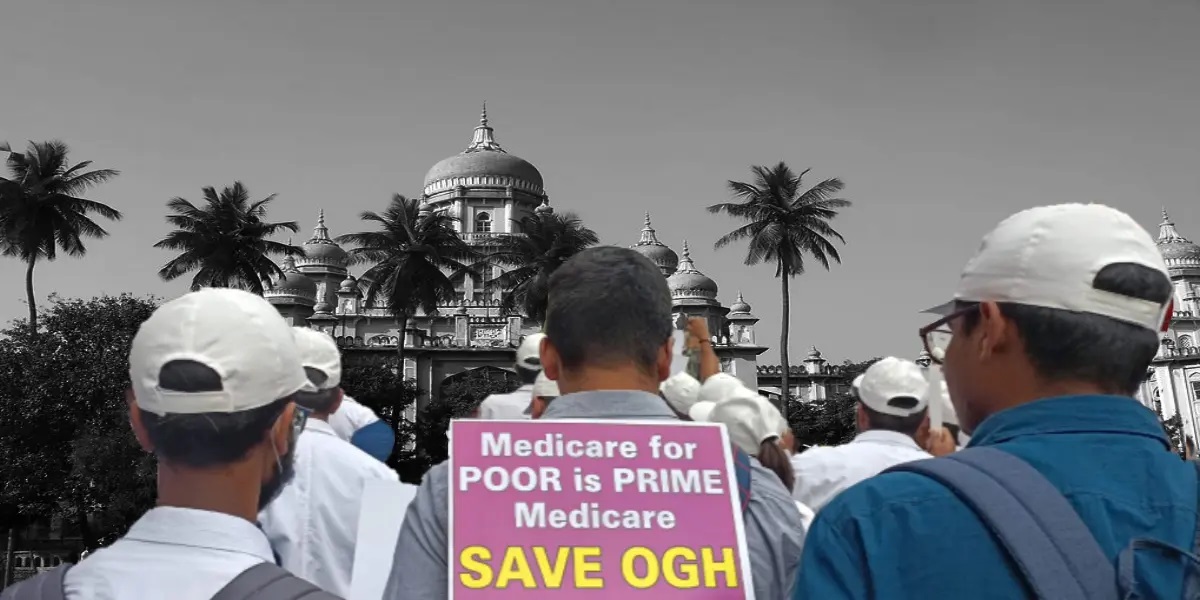With only two years left to eliminate tuberculosis and nine years left to achieve the SDG target of universal health coverage, the Budget leaves a huge gap between promises and execution.
Published Feb 03, 2023 | 7:34 PM ⚊ Updated Feb 03, 2023 | 7:34 PM

The present allocation of ₹89,155 crore for health is about ₹3,000 crore more than last year. But when adjusted for inflation, it is the same or might be even slightly lower than the previous year. The photo is of Osmania General Hospitals, Hyderabad (Sumit Jha/ South First)
Before looking at the Union Budget 2023, let us look at the present challenges in the health sector.
The population is stabilising. Very soon, we shall have a disproportionate number of people in the geriatric age group and their medical needs will be a major challenge.
Most of them cannot access the expensive private tertiary healthcare system. Nearly one in three among those between the ages of 60 and 74 years are reported to have either a heart disease or hypertension or both.
With an ageing population, these health problems will increase the burden on our health system, which currently produces only 52 geriatric medicine specialists every year.
Even cataract services are not freely available in many parts of the country.
A significant proportion of our adolescent and pregnant women continue to be anaemic and iron deficient.
In spite of pumping tons of iron and folic acid over years, the situation has not improved. In fact, it has worsened — from 53.1% in NFHS-4 (2016–18) aged between 15–49 years to 57% in NFHS-5 (2019–21).
A good percentage of our children in the school-going age are stunted (35.5%) or wasted (19.3%) or both.
This is also coupled with rising obesity in this age group, ultimately leaving very few healthy kids in the country.
Many studies across several states show that diabetes and hypertension are increasing among the rural poor.
Diagnosis, ensuring drug compliance, regular supply of drugs, and prevention of complications are significantly more challenging when it comes to the rural poor.
The incidence of TB, its morbidity, and death rate remain stagnant for almost 30 years.
Emergence of Multidrug Resistant TB (MDR TB) is a significant area of concern. Partial and incomplete treatment is a significant contributing factor.
Out-of-pocket expenditure is one of the highest in India at around 65%.
It remains a major cause of rural impoverishment. The only way to decrease this is to increase the health budget to around 3% of GDP.
Cancer care in India has improved over the years. However, good quality care is still inaccessible for the majority.
With most oncologists working in urban areas, the rural people, forming 70% of the country’s population, still find it difficult to access timely and affordable treatment.
Access to morphine is still abysmal in the country with people with end-stage disease lacking the privilege of a dignified and pain-free death. Cancer chemotherapy can impoverish even a middle-class family.

Sarojini Devi Eye Hospital, a government hospital in Hyderabad (Sumit Jha/ South First)
The precious lesson that we learnt from Covid is that countries that had a strong public health system fared better than those that did not.
Hence it would be prudent to strengthen our PHCs, district and taluk hospitals, and employ more medical and paramedical personnel with greater emphasis on primary, preventive, and domiciliary healthcare including palliation.
There is an enormous need for dialysis and deaddiction centres. Both are scarce and expensive in the private sector.
Sadly, we see not one of these concerns being addressed in the Union Budget 2023.
A millet research institute is not going to promote cultivation and consumption in the near future. Millets cannot address the issue of protein deficiency.
The opening of 150-odd nursing colleges is good. We need more qualified nurses. But there is no indication of how many nurses we will produce each year and how many can be absorbed in the primary and secondary healthcare sector of the government.
India currently faces a problem of health workforce attrition. Increasing production of the health workforce is futile if the causes of attrition are not addressed at the same time.
The present allocation of ₹89,155 crore is about ₹3,000 crore more than last year. But when adjusted for inflation, it is the same or might be even slightly lower than the previous year.
According to WHO, investment in health gives nine times as much in return. With only two years left to eliminate tuberculosis and nine years left to achieve the SDG target of universal health coverage, the Budget leaves a huge gap between promises and execution.
(Dr J Amalorpavanathan is Member, State Planning Commission, Government of Tamil Nadu. Dr Parth Sharma is a Fellow, Lancet Citizens’ Commission on Reimagining India’s Health System. Views expressed are personal and do not reflect that of the organisations the authors work for)

Jul 25, 2024

Jul 25, 2024

Jul 24, 2024

Jul 24, 2024

Jul 24, 2024

Jul 24, 2024